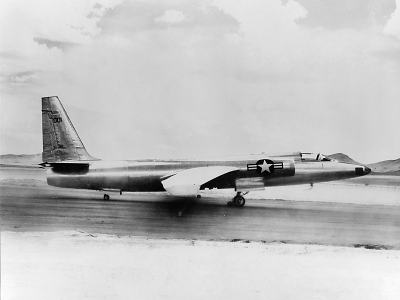
Article 341 served as a test aircraft at Watertown, Nevada, from July 1955 until it was lost in an accident in April 1957.
 Article 341 served as a test aircraft at Watertown, Nevada, from July 1955 until it was lost in an accident in April 1957. |
As flights progressed to higher altitudes, trouble developed with the J75-P-37 engine. Fuel control was unsatisfactory, the bleed valves didn't work properly, and flameouts occurred with alarming regularity. An improved J75-P-31 engine arrived in January 1956 and was installed in Article 341. The engine's performance problems were eliminated, but the new engine could not be restarted in flight above 35,000 feet.
The U-2 prototype's final test program involved the development of a way to make the airplane less visible to radar. Working with physics professor Ed Purcell and Dr. Frank Rogers of the Massachusetts Institute of Technology (MIT), Lockheed engineers worked to create the world's first "stealth" airplane. Luther McDonald led the Skunk Works team, assisted by Mel George and Ed Lovick. They modified two U-2 test aircraft for a series of radar cross-section reduction tests called Project RAINBOW in early 1957. Article 341 received a coating of high-frequency radar absorbent material (RAM) on the underside of the aircraft. The RAM, varying in thickness from a quarter-inch to about one inch, featured a fiberglass honeycomb topped by layers of Salisbury Screen, an absorber with a conductive graphite grid on canvas. It was nicknamed "wallpaper" because of the circuit grid pattern on its surface. This type of RAM was capable of absorbing radar energy in the 65- to 85-MHz range. With the RAM attached, the U-2 suffered from excess weight and drag, making it aerodynamically "unclean." Hence it was known as a "Dirty Bird." The modifications reduced the airplane's maximum altitude by 5,000 feet and cut its range by 20 percent. Additionally, the RAM coatings prevented the dissipation of engine heat through the aircraft's skin.